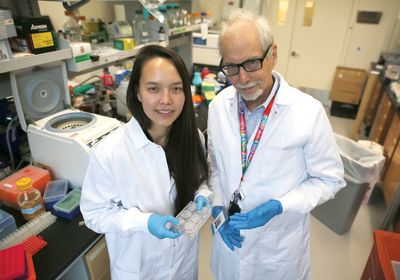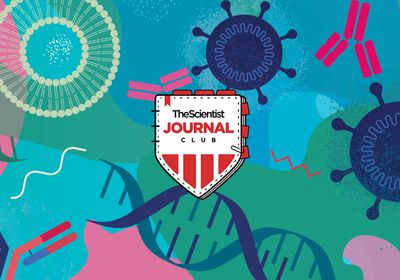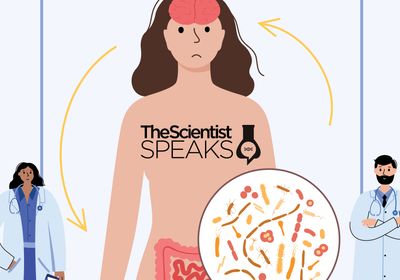ABOVE: Julie Trolle and Jef Boeke use synthetic biology methods to enable mammalian cells to create essential amino acids. Courtesy of Julie Trolle
Whenever students approach geneticist Jef Boeke claiming that they’ve made a cool new discovery, his first reaction is always, “Show me the plates.” Boeke is the founding director of the Institute for Systems Genetics at NYU Langone Health, and most of the work in his lab focuses on microorganisms. Looking directly at his students’ cells under the microscope helps him pick out details that could lead to interesting discoveries, so when NYU Grossman School of Medicine PhD student Julie Trolle sent him pictures of her genetically engineered Chinese hamster ovary (CHO) cells in 2017, he knew that he needed to see them for himself. What he saw was the resurrection of an amino acid synthesizing pathway that was lost in animals more than 500 million years ago.
In total, 20 amino acids make up the thousands of different proteins in all life forms. But animals can only make 11 of them; they have to pick up the other essential amino acids from their environments. They do this by consuming plants, which typically make all 20 amino acids, or eating animals that have consumed plants. Given that most plants and microorganisms carry the pathway for all 20, the missing nine raise questions about animal evolution: When and why were these pathways lost? And could animals somehow produce the amino acids again? Trolle was particularly interested in using synthetic biology and engineering to address this second question, and in doing so, potentially lay the groundwork for solutions to various medical and industrial problems.
Making the engineered cells didn’t come easily, she said. The animal ancestor with these synthesis pathways lived at least 500 million years ago. The interactions between the enzymes necessary to make the amino acids certainly were not the same in those ancestors as in the CHO cells in Trolle’s culture plates.
She opted to focus her efforts on valine because of its chemical similarity to isoleucine, another essential amino acid. A cell that could produce valine might also produce isoleucine, she said, potentially making this more efficient than engineering a single amino acid production pathway.
She started by introducing bacterial genes that encode enzymes not normally produced in animal cells into industry standard CHO cells. She hoped that the cells would then be able to convert biochemical compounds in their environment into valine and isoleucine. Trolle put her modified cells and a group of control cells into media that lacked one or both of the amino acids to see whether they’d survive.
To her disappointment, the cells did not survive well without isoleucine in their culture medium, no matter what tweaks she made to the pathway, indicating that they did not make any of the amino acid. However, Trolle’s cells continued to survive well in valine-free medium.
The differences in outcome between the regular cells and the genetically modified ones was “more than convincing,” Boeke said. The genetically modified cells survived better than control cells, implying that they produced the essential amino acid on their own.
Trolle measured valine levels in the culture medium to confirm that the cells synthesized valine when fed glucose and pyruvate. “It was an amazing success,” said Boeke. “We were so excited.” However, when the team submitted the results for publication in 2021, reviewers were skeptical. Valine production in Trolle’s cells began to peter out starting at 20 days, and much more so by 40 days. The reviewers noted that the CHO cells ought to be able to produce valine at a consistent rate.
With the help of Boeke and other researchers, Trolle tried different tweaks without success. Finally, however, she made a breakthrough. She discovered that the problem with the pathway was a buildup of an intermediate compound made by the cells. To correct this, Trolle tried adding an extra copy of the gene that coded for the enzyme that converted that intermediate into the next product.
The change worked; suddenly, the cells produced valine at a higher rate than the earlier batch of cells. And valine production increased consistently throughout the 40-day experiment.1 “It’s the first animal cell to produce valine that has ever existed,” said Trolle, who is now a postdoctoral fellow in Boeke’s lab.
“It’s a pioneering and encouraging result,” said Andrew Hessel, a cell biologist and geneticist who cofounded the cancer therapeutics company Humane Genomics and cofounded and chairs Genome Project-write, an international research effort focused on genome editing and synthesis. Hessel wasn’t involved with the research, although he has previously collaborated with Boeke and another of the study’s authors. “This is a really cool first step towards making a fully autotrophic cell,” Hessel said.
Now that Trolle has demonstrated that an essential amino acid producing animal cell is possible, Hessel said that it’s only a matter of time before others follow in her footsteps with different amino acids. “We will end up seeing a cell that can make all of its amino acids in the next few years,” he said.
Trolle hopes that the work will have applications for cell culture methods. The medium used to feed the CHO cells she worked with, for instance, is expensive and often relies on animal products. Working with autotrophic cells would be easier and more cost efficient and would make processes such as growing meat in a lab more feasible. “Any sort of application involving culturing mammalian cells at large scales is likely going to require some genome engineering in order to make it scalable,” she said. “This is taking a first step towards making that kind of thing happen.”
According to Stanford University synthetic biologist Drew Endy, who was not involved in the study, these pathways could be engineered to create other amino acids that have never before been biosynthesized. Such technology could lead to the production of new proteins and medicines, said Endy, who invests in synthetic biology companies and cofounded and still advises the DNA construction company Gen9.
Moving beyond the CHO cells, Boeke is interested in incorporating the newly engineered pathways into embryonic stem cells, potentially engineering a mouse that could produce its own valine, which might be cheaper to feed in the lab. However, Boeke said that for now, projects such as a fully autotrophic animal cells are still the stuff of science fiction, adding that there may be “some unforeseen consequences of having cells actually produce these [amino acids].”
Hessel is nonetheless impressed by the work, and particularly the use of bacterial genes to enhance mammalian cells. “Our mammalian cells have a lot to learn from bacteria,” he said. “It is remarkable that bacteria are teaching us how to be more independent.”
Reference
- Julie Trolle et al., (2022) Resurrecting essential amino acid biosynthesis in mammalian cells eLife 11:e72847





